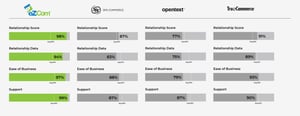The Battle for Your eCommerce Store.
While they are hardly the only players in the space, Magento and Shopify may have the most buzz among eCommerce platforms.
In May, Adobe agreed to acquire Magento, and that move has raised the stakes in a category that was already very competitive. Meanwhile, Ottawa-based Shopify powers more than 600,000 stores and wins customers with its user-friendly interface and ease of use.
If you’re looking for a solution for your eCommerce store and have narrowed it to a choice between Magento and Shopify, how will you decide which one is right for you? The differences are quite sharp.
Here at eZCom, we have connectors to both platforms and our Lingo software integrates orders from either one seamlessly. When it comes to eCommerce platforms, we’re relatively agnostic. But we would like to help you understand the pros and cons of both.

Shopify – Pros and Cons
Let’s start with Shopify, the rapidly growing platform that has generated all kinds of buzz, especially since its 2015 IPO.
Shopify – Pros
- It’s straightforward. Central to Shopify’s appeal is its usability. With this hosted platform, you don’t need to be a programmer or even know anything about programming— it’s built to be easy for someone with limited technical knowledge. You simply choose a plan, point the domain you own to your Shopify store, select a template or have one designed yourself, upload your products and payment options, and go. You’re off and selling.
- It’s fast. No customer is more impatient than an online shopper, and even a few seconds can be the difference. Cloud-based Shopify keeps transactions fast.
- It’s secure. You’re going to be processing credit card payments and Shopify has made the investment necessary to ensure that information stays safe.
- It makes analysis easy. The analytics tools let you easily track everything, so you know which products are hot and which ones are not.
- It’s fully supported. Customer service from Shopify is first-rate and there is a huge database of forums and FAQs.
- It has an App Store. If you need a feature that isn’t built into Shopify, it’s good to know they have followed the Apple model and started an App Store. Chances are, you’ll be able to find the specialized product you need.
|
Shopify – Cons
- While it's less expensive than Magento, it's not the cheapest option out there. The packages are definitely competitive and you won’t have to invest in a developer to make fixes, but it won’t be the least costly solution.
- It’s only average for blogging. If you’re used to WooCommerce and WordPress, the blogging software that comes with Shopify will be underwhelming.
- It’s not easy to leave. If you find you don’t love Shopify, leaving the platform can be complicated.
- It doesn't scale as well as Magento. As you grow, you might find the need for custom solutions, and Shopify isn't the best solution for that. If you're successful, you may need to switch to another platform just as your business is really taking off.
|

Magento – Pros and Cons
Since an acquisition by Adobe Systems was announced in May of 2018, eCommerce platform Magento has been set to grab a bigger slice of the market. Let’s take a look at it.
Magento – Pros
- It’s feature-rich. In some ways, comparing Magento and Shopify is a bit like apples and oranges. Magento is open-source, and it’s built to manage a lot — multiple storefronts, different languages, different currencies.
- It can be free. At least the Community version is, and the large user group has developed many extensions and plug-ins.
- It’s user-friendly. The back-end navigation is intuitive and thoughtfully organized.
- It’s flexible. You can customize the site so it has the kind of functionality you want.
- It’s scalable. 10 products or 100,000 products — Magento can grow with your business.
|
Magento – Cons
- It’s not cloud-based. While some may see this as an advantage, the size of Magento dictates hosting it on dedicated servers. If you run it on typical shared hosting, you’ll sacrifice speed and create a frustrating experience for buyers.
- It requires developer skills. Magento isn’t plug-and-play. Unless you’re a developer yourself, you’ll need to hire someone, and Magento talent is in short supply. You’ll want to find someone who has experience with it.
- It gets pricey. Sure, the Community version is free but once you move up to the Enterprise version you’ll be paying serious dollars. And it goes up from there when you move to the Premium Enterprise version. Of course, that means your business is all grown up and probably doing very well.
- It requires time. Working with Magento means investing real hours. That can mean everything from all the time it takes to get a developer up to speed to the time that will be devoted to customizing or upgrading it.
|

I say Shopify, you say Magento. Or the other way around.
There are real differences between Shopify and Magento, despite the fact they are pursuing many of the same customers. Which one is right for you will depend on all kinds of factors, ranging from your own company’s growth plans to your level of comfort with development. Both are powerful options that are behind all kinds of eCommerce stores and helping entrepreneurs launch online businesses.










